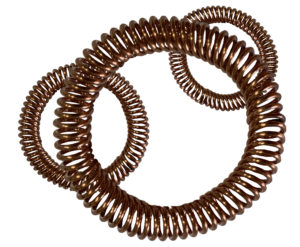Canted coil springs are an effective, reliable solution for some of the toughest EMI/RF shielding challenges. But what makes them different from other options, like wire mesh over polymer and finger springs?
What Are Canted Coil Springs?
Sensitive electronics need protection against EMI (Electromagnetic Interference) , RF (Radio Frequency), and crosstalk, and they need to avoid interfering with other electronics. Among the EMI/RF shields on the market are canted coil springs. These springs get their name from the angle at which the individual coils are set. This allows them to achieve a consistent, highly predictable force once installed, which makes them ideal for latching, locking, and holding as well as spring-energized seals. As just mentioned, they also provide highly reliable EMI/RF shielding made possible in part because each coil serves as a contact point for conduction or grounding.
Where Canted Coil Springs Are Used for EMI/RF Shielding
Canted coil springs are used in a variety of applications where they provide shielding for data and signal transfer, including

- Antenna bases
- Power management systems
- Electronic enclosures
- Waveguide flanges
- Cabling
- Connect/disconnect assemblies
- Coaxial and electrical connectors
Whenever EMI/RF shielding is involved, there are critical national and international standards that must be complied with. These standards come from several different organizations, including the following:
- CISPR (Comité International Spécial des Perturbations Radio), dealing with emission and immunity as well as test methods and the equipment used for testing
- IEC 61000 (International Electrotechnical Commission) focusing on EMC (Electromagnetic Compatibility)
- ISO (International Organization for Standardization) standards specifically for automotive EMC concerns and covers road vehicles, earthmoving equipment, and forestry and agricultural machines
- SAE (Society of Automotive Engineers) EMC Standards Committee
- EN (European Norm) standards concerning unwanted electrical emissions and immunity to unwanted electrical emissions
- FCC Part 15 (Federal Communications Commission) for unlicensed radio-frequency transmissions
- MIL-STD 461, 464, and 469 (Military Standard)
For a product to be sold on either the national or international market, it must be in compliance with relevant standards. To learn more about canted coils, click this link to read the most common questions about canted coil springs.
Benefits of Canted Coil Springs for EMI/RF Shielding
There are several advantages to using canted coil springs for EMI/EF shielding, starting with their ability to serve two or more different purposes in a single design.
Multipurpose Mechanical and Electrical Solution
Canted coil springs can be used for multiple purposes in a single application: they also perform latching, holding, and locking functions. They do so with highly predictable forces and almost no compression set. When they are designed correctly, these springs can provide precise insertion and breakaway forces. Canted coil springs perform these mechanical functions without the use of tools and can significantly simplify a design when used as a multipurpose solution (i.e., latching and EMI shielding).
Lightweight and Flexible
Canted coil springs are extremely lightweight and compact, which can make them an excellent option for SWaP (Size, Weight, and Power) constrained applications. Their flexibility allows them to be used with many geometries other than circular that would be otherwise challenging to shield.
Geometric Options
Standard spring wire is available in wire diameters from 0.25 mm (0.010 inches) to 1.50 mm (0.059 inches). Standard coil widths range from 1.5 mm (0.039 inches) to 15 mm (0.591 inches). However, there are custom options available for wire diameter and coil width. The angle at which the coils are oriented can also be specified. Finally, the coil pitch can be varied, and is usually quite dense for EMI/RF applications.
Material and Plating Options
There are several different material and plating combinations available for canted coil springs. The most commonly used spring materials include …
- Stainless steel
- Beryllium copper
- Zirconium copper
- Inconel
- Hastelloy
- Platinum iridium.
These materials can be combined with platings such as nickel, silver, gold, and tin. Platings are especially useful when the springs may be exposed to corrosive environmental conditions.
Impedance Tuning
While canted coil springs already work across a very broad spectrum of EMI interference, they can also be tuned to very specific impedance specifications. This can aid not only in device performance but in achieving compatibility with the appropriate EMC/RF standards.
Reliability
Because canted coil springs can provide a near-constant force, they will remain in contact with surfaces extremely well. This is true even when subject to vibration, shock, and impact loads as well as dimensional changes due to temperature fluctuations. Canted coil springs do an excellent job of compensating for hardware variations, surface irregularities, and angular misalignment, leading to highly reliable performance even in difficult operating conditions.
Conclusion
If you are looking for an economical, effective, and reliable EMI/RF shielding solution, consider the use of canted coil springs. And the experts here at Advanced EMC can help you choose the right spring options, tune it to the impedance you need, and ensure that your design will comply with the right standards. Contact us today to learn more about our Flex-Force canted coil springs.
